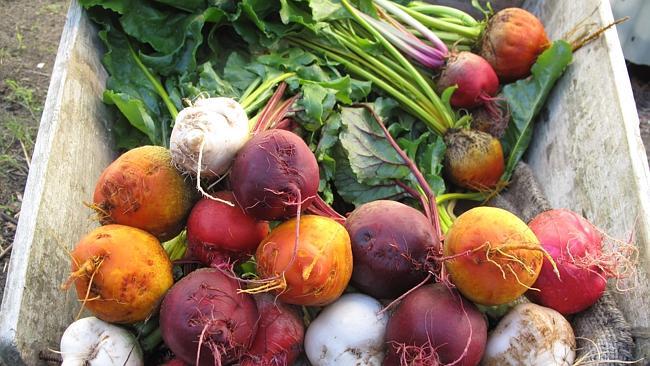Alla Wolf-Tasker, Lake House, Daylesford: autumn recipes
Dishes featuring richly-toned fruits and vegetables, warm to the eye and tongue, are a treat at this time of year

Dishes featuring richly-toned fruits and vegetables, warm to the eye and tongue, are a particular treat at this time of year.
Beetroot, emerging from underground, the earth still clinging to its delicate threads, is the taproot of the beet plant. Its equally beet-flavoured leaves, fresh, green and red-veined on just-pulled roots, add subtle flavour to salads. Market sellers understand the virtues of these leaves, where supermarkets do not. But the root itself is a dark gem, in colour and flavour; in season April into August.
One of beetroot’s natural affinities is for goat’s cheese ; light, fresh, slightly acidic, it’s at markets around the country, often from local goat farms. Ann-Marie Monda and Carla Meurs make Holy Goat Cheese at Sutton Grange Organic Farm (Victoria), selling at local Castlemaine and Bendigo, and Melbourne markets. Meredith Dairy, another family farm in regional Victoria, sells around the country. In the Adelaide Hills, Saul and Sheree Sullivan make goat’s milk cheeses at Udder Delights; they have a cheese cellar in Hahndorf, with distributers in all states. Jannei goat dairy (NSW) sells its products (including raw goat’s milk) in selected stores countrywide. Today’s chef chooses sharper feta for her beetroot dish, saving goat’s cheese for a warm custard.
Quinces have an ancient history, originating in the Fertile Crescent of the Tigris and Euphrates river basin. Pale, ungainly, brushed with a downy fuzz, they emerge from long, slow cooking, a fragrant mahogany-dark feast. In markets from Hawkesbury Harvest, NSW, to Victor Harbor, SA, April to June.
judithattakethree@gmail.com
RECIPE SUGGESTIONS
By Alla Wolf-Tasker AM
Culinary director of the award-winning Lake House, Daylesford, Victoria.
BEETROOT
This region grows magnificent beets, including multi-hued heirloom varieties. They’re a strong reminder of my childhood. Russians eat them in their zakuska (hors d’oeuvres) tables. Delicious, and a strong blood cleanser. If fresh-picked, as ours are, their green tops are splendid sauteed with olive oil, lemon juice, good salt and fresh-ground pepper.
Simple beetroot salad
Chop greens (leaving about 4cm) from medium beetroots. Wash; do not peel. Wrap individually in foil; cook about 40 minutes, in preheated 170C oven until easily pierced with a knife. Allow to cool; top and tail, peel (skin should slip off easily). Cut each into 6-8 pieces, depending on size. While warm, season well, toss with olive oil and lemon juice. Combine with the green tops if available. Toasted walnuts make a good addition, or even cooked, tiny green French-style lentils. Ensure everything is well dressed; scatter with crumbled feta.
GOAT’S CHEESE
I love a warm savoury custard made from fresh goat’s cheese. It pairs beautifully with sauteed autumn mushrooms, or even the beetroot salad, and can be reheated.
Goat’s cheese custard
For 12 small custards, sweat 3 chopped shallots and sliced white of 1 leek in a little butter until soft. Pour on 300ml milk combined with 300ml cream, add bay leaf and 3-4 thyme sprigs. Heat to simmer. Remove from heat and allow flavours to steep. Gently reheat and strain into a bowl over 300g fresh goat’s cheese. Stir, ensuring a smooth mixture. Whisk 6 eggs until smooth, add to cheese mixture, ensure smooth combination. Season well. Divide between 12 pliable dariole moulds. Bake in a bain marie, hot water halfway up moulds, in a 170C oven. They take around 20 minutes to set, remaining a little wobbly in the middle. Allow to stand a few minutes before turning out. Serve alongside fresh salad. Or refrigerate until ready to use; gently reheat about 30 seconds each in a microwave or 15mins in a moderate oven.
QUINCES
Autumn is such a prolific season, I am loath to select favourite produce. It’s one of the best times of year to forage down country tracks around Daylesford. Wild-seeded apples and pears offer bounty for my basket. And there are wild mushrooms. However my season’s favourite cooked fruit has got to be quince.
We have a couple of varieties growing at Lake House. Placed in bowls around the place they perfume the air. They can be poached or pot-roasted and produce a beautiful ruby-red jelly that generally sets well. The slower you cook them, the deeper their colour.
Pot-roasted quinces
Peel, halve and core 2.5kg quinces. Heat 2 litres water with 1.8kg sugar, dissolving. Add peel, cores. Bring to a simmer, cook till reduced by at least a third.
In a roasting pan, pour syrup and peelings over quinces to cover. Seal tray with foil, cook at 100C, 6-8 hours, until fruit is red and soft to the touch. Strain syrup. (With slightly under-ripe fruit, the syrup can often gel if reduced further.) Refrigerate fruit in sealed containers drizzled with a little syrup. Beautiful in tarts or fruit-topped cake, but my tip is warm-roasted quince piled on French toast, with a dollop of great yoghurt (try that with the morning’s first espresso!).


